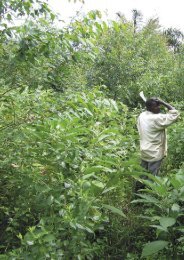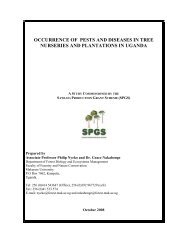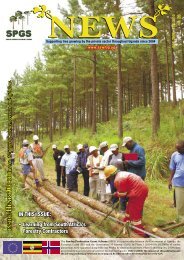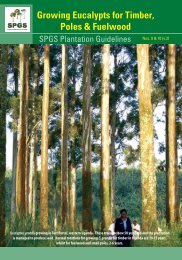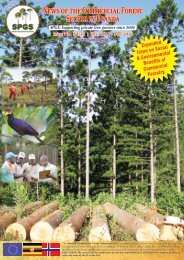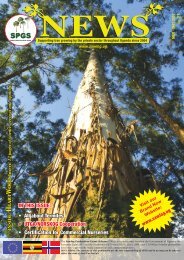COMMUNITY TREE PLANTING GUIDELINE - SPGS
COMMUNITY TREE PLANTING GUIDELINE - SPGS
COMMUNITY TREE PLANTING GUIDELINE - SPGS
You also want an ePaper? Increase the reach of your titles
YUMPU automatically turns print PDFs into web optimized ePapers that Google loves.
LAWLOG PRODUCTION GRANT SCHEME<br />
6. When the baseline has moved up to the end of<br />
the two cross lines, then steps 1-5 are repeated<br />
until the whole site is covered.<br />
Diagram showing 3,4,5 rule for marking cross line CE at right<br />
angle with the base line CA. Pegs are fixed into the ground at<br />
points BCD to hold tight the measuring tape before extending<br />
the lines to points A and E.<br />
3. Now, go and repeat this to mark off another<br />
cross line (AE) at right angle with the base line<br />
from point A. Cross line AE should now be<br />
parallel to cross line CE as shown on diagram<br />
below<br />
7. When lining out on steep slopes or hill (more<br />
than 20 o slope) it is important to do slope<br />
correction otherwise, the distance between<br />
trees will be lesser than expected. The same<br />
procedure of lining out as described above is<br />
followed. However, now the base line or cross<br />
line needs to be lifted up from the lower end of<br />
the slope such that its top end at point A is on<br />
the same height as its lower end at point B as<br />
shown by rope AC on diagram below.<br />
Now your cross line or base line should appear<br />
as shown by rope AC (3M) whose 3M mark<br />
C<br />
Diagram showing how to mark holes on the<br />
ground between cross lines CE and AE along<br />
direction ‘d’<br />
4. These two cross lines on both ends of the<br />
baseline should then be marked with the chosen<br />
spacing say of 3m intervals.<br />
5. After marking these two cross lines, the rope<br />
forming the baseline can now be kept moving<br />
up between the two cross-lines while stopping<br />
at each mark 2, 3-7 on the two cross-lines as<br />
directed by arrow ‘d’ above. As this rope is<br />
being shifted on the two cross lines, a person<br />
then keeps on marking planting holes on the<br />
ground by digging shallow holes corresponding<br />
to the spacing marks on the rope.<br />
13<br />
Lining out on a slope needs you to keep the cross line rope not on<br />
the ground level but be raised up at the same height as the upper<br />
end (A). A pole then can be used to locate the point (B) where the<br />
next pit down the hill should be dug.<br />
on the ground is determined by a vertical pole<br />
CB. Next, with your pole still at the same mark<br />
B, lower the rope AC to lie on the ground and<br />
hold it tight at both ends. You now find that the<br />
rope AC of 3M long when placed on the steep<br />
ground does not cover the full length AB but<br />
ends some where at point D.<br />
Therefore, measure length DB and add this<br />
to the spacing being used in order to get the<br />
true distance AB on the steep ground. If DB<br />
is 30cm or 0.3M then add it to our spacing of<br />
3M that is 3 + 0.3 =3.3M. This means all the<br />
trees on this particular slope should be spaced<br />
at 3.3m x 3.3m. In this case, the 0.3M is our<br />
slope correction factor. You can then mark your<br />
rope at 3.3m spacing.<br />
After successful lining out, the next step is to proceed<br />
to pitting.<br />
Community Tree Planting Guideline



